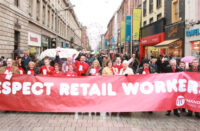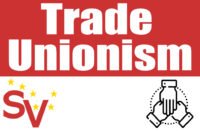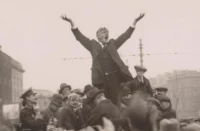In the July Voice, Nicola Lawlor proposed that “individual unions should concentrate on… strengthening themselves and militantly pursuing big pay claims.” She argues that unions should not be “remov[ed from] pay bargaining [at the workplace] site of struggle and mobilisation.” Localised bargaining is “an instrument… for increasing class-consciousness and militancy in the struggle…”
The crux of the argument is that unions militantly pursuing wage demands in the workplace (presumably backed by strikes) can increase class-consciousness.
Now, assume that “class-consciousness” has two dimensions: industrial (willingness to become a union member) and political (willingness to join or support a workers’ party).
Consider the industrial. Strikes in Ireland are predominantly about wages, so periods of high strike frequency reflect periods of militant pay bargaining. Say high frequency is characterised by 100+ strikes annually: we find that since 1922 high strike frequencies have occurred in the early 1920s, mid-to-late 30s, mid-to-late 40s, mid-to-late-60s, the 1970s, and early-to-mid 1980s. If strike waves result in greater class-consciousness we might expect to see accelerated changes in the annual rate of union membership following periods of high frequency relative to periods where strike numbers are much lower. The increased propensity of workers to strike sends a demonstrative signal to others and raises their industrial consciousness.
Yet only the waves of the 1930s and 40s are associated with significant changes in the annual rate of change in trade union membership growth. The other waves do not replicate that trend. There was stagnation in the rate of membership change. There was also a deceleration of employment density from the late 1960s onwards and through the 1970s. Such trends occur despite the historically high strike frequency of that period and the larger number of workers involved relative to the 1930s and 40s.
This suggests that high frequency (and even large numbers of strikers) may not always increase industrial class-consciousness if benchmarked by increased rates of workers joining unions. It may depend on the character of the strike, i.e. offensive v. defensive strikes.
Now consider political class-consciousness. Consider the trajectory of the Communist Party of Ireland as representing class-consciousness par excellence. Lacking data on membership and vote share, we can look at the official (re)constitution of the CPI over time—1921, 1933, and 1970—instead. Evidence suggests that all three (re)constitutions occurred in periods of high strike frequency. Strike waves were associated with a desire by a small number of militants to (re)establish a class-oriented political party.
Strike waves were also associated with an increased electoral share for the Labour Party (except in periods associated with coalition government). A similar trend occurs with Clann na Poblachta and the Workers’ Party, but such shares do not hold up well.
Strike waves might be positively associated with increased political class-consciousness evident in establishing and voting for left parties. If we assume a causal link, the effects seem tiny, however, confined to small groups of activists or manifested in modest and transient vote shares. This assumed “activist effect,” although small, might be very important in sustaining the political organisations of the working class.
One could refine these (impressionistic) assessment with a more precise statistical analysis. Nonetheless it seems to suggest that Irish communists should use episodes of militant pay bargaining, backed by strikes, to identify, educate and recruit valuable activists. It seems less reasonable to expect seismic uptakes in the rate of union membership due to strike waves without more fully understanding the character of those strikes.
Finally, it is not unreasonable to suggest that localised militant pay bargaining can have adverse effects on “net aggregate” class-consciousness. We might balance workers whose class-consciousness increases by localised militant pay bargaining with those workers who fall prey to reactionary postures. The latter is probably because of actual or perceived negative experiences of strike action, e.g. disruption to goods or services for workers as consumers, higher wages passed on in the form of higher prices to workers as consumers or retired workers as pensioners, workers’ susceptibility to the capitalist media, manipulation by anti-worker political forces, petty sectionalism, etc. Such “debits” from the “account” of class-consciousness seem likely if local action is isolated.
Workers and their unions probably need the support of a robust political organisation to help counter well-organised reactionary forces at a sufficiently broader societal level.






